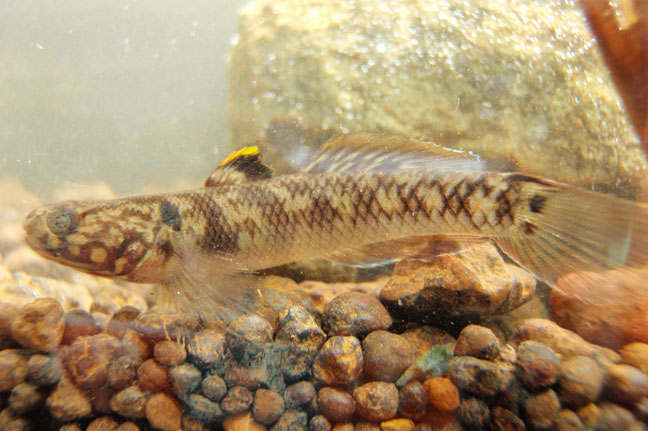- Classification
- ACTINOPTERYGII
- PERCIFORMES
- GOBIIDAE
- Mugilogobius
- notospilus
Freshwater Mangrovegoby, Mugilogobius notospilus (Günther 1877)
Other Names: Freshwater Mangrove Goby

Freshwater Mangrovegoby, Mugilogobius notospilus. Source: Christine Pollabauer. License: all rights reserved
Summary:
See 'More Info' tab
Cite this page as:
Martin F. Gomon, Mugilogobius notospilus in Fishes of Australia, accessed 27 Jun 2025, https://fishesofaustralia.net.au/Home/species/3064
Freshwater Mangrovegoby, Mugilogobius notospilus (Günther 1877)
More Info
|
Distribution |
Distributed in northeastern Australia from the Daintree River (16°15'S), to Cardwell (18°16'S), QLD and elsewhere in the tropical western Pacific; a benthic species in estuaries, mangroves, mud bottom inshore marine and freshwater areas; in short tributary streams close to river mouths fed by drainage from well vegetated rainforest catchments; streams bordered by lowland rainforest with some mangrove and palm forming closed canopy; substrate predominantly fine gravel and sand, and occasionally mud, with areas of dense leaf litter. |
|
Features |
D VI; I,7-8; A I, 7-9; P 14-16; C (segmented rays) 16-17, (branched rays) 13-16; TRB 9-12; GR 3-4 + 7-12 = 10-16; Vert 10 + 16-17. Body relatively compressed, especially posteriorly; depth 4.0-6.1 in SL. Head rounded, length 2.6-3.9 in SL, somewhat depressed anteriorly, always wider than deep. Snout rounded in dorsal view, plump, profile often rounded. Anterior nostril tubular, just behind upper lip, tube often short, directed forward and down over upper lip; preorbital sometimes curved outward slightly to accommodate nostril tube; posterior nostril rounded to oval, close to anterior edge of eye centrally. Eyes lateral, high on head, forming part of dorsal profile, 3.1-4.2 in head. Interorbital broad, sometimes slightly concave; interorbital and adjoining unscaled area of predorsal often covered with dense villi, often on snout past level of posterior nostril. Mouth subterminal almost to terminal, slightly oblique, reaching to below anterior or posterior half of eye in males, to anterior half or to mid-eye in females; lips smooth, lower lip free at sides, fused to symphysis anteriorly. Gill opening extending forward to below opercle; inner edge of pectoral girdle smooth edged, with low irregular fleshy ridge or fleshy flange or with fleshy knobs, lobes or bumps; knobs arising from raised ridge or directly from smooth edge of pectoral girdle. Tongue tip usually blunt or concave. Jaw teeth in 4-5 rows, outer row in upper jaw largest, stout, curved or nearly conical, others small, sharp, evenly-sized; males and females similar. Body fully scaled, broad to narrow wedge of ctenoid scales forward to behind pectoral fin; lateral line absent; longitudinal series 28-36; predorsal scales small, cycloid, usually forward nearly to eyes or at least halfway between preopercular margin and rear of eyes, 12-20 on dorsal midline; operculum usually with cycloid scales on upper half; cheek naked. Pectoral base fully scaled with small cycloid scales; prepelvic area covered with small cycloid scales; belly scales ctenoid under pelvics, anterior 1/4–1/3 of belly scales ctenoid, remainder cycloid. Head pores absent. Two dorsal fins, first low, depressed fin at most reaching origin of second dorsal fin; second dorsal and anal fin rays at most reaching to base of caudal fin in large adults; 2nd or 3rd dorsal fin spines longest, none elongate or filamentous. Pectoral fin rounded to rhomboid, all rays except first usually branched in adults, reaching to above anus. Pelvic fins united into complete disc, oval to slender, reaching halfway or nearly to anus. Caudal fin rather short, rounded to oval. |
|
Colour |
Pale yellowish above, whitish below, with scale margins narrowly outlined in brown giving cross-hatch effect to 7 bars on side of body; dark brown blotch just above pectoral base; pectoral base pale yellowish, with brown bar from pectoral girdle onto base of pectoral fin, nearer upper edge of base than lower; white pectoral base divided in two by blackish bar, orange pigment in front of and behind white area; indistinct dark blotch at caudal base; head with 4-5 brown lines radiating from eye and forming reticulate pattern across preopercle and opercle, less distinct on opercle; often side of head entirely brown with round white spots; underside with 3 brown to blackish stripes; iris golden. First dorsal fin translucent to dusky, with narrow black marginal stripe and broad black central stripe more intense posteriorly as black spot on membrane between fourth and sixth spines; base of fin pale yellow, dusky stripe present at least anteriorly. Anal fin reddish orange on proximal half, dusky submarginal stripe, and bluish white margin. Caudal fin base whitish with 2 round black spots at centre; black streak along upper procurrent rays; rest of fin translucent whitish with dusky margin. Pectoral and pelvic fins whitish. |
|
Species Citation |
Gobius notospilus Günther, A. (1877). Andrew Garrett's Fische der Südsee. Heft 6. J. Mus. Godeffroy 4(13): 169–216 pls 101–120 [173, pl. 109, fig. B]. Namusi, Viti-Levu, Fiji. |
|
Author |
Martin F. Gomon |
Freshwater Mangrovegoby, Mugilogobius notospilus (Günther 1877)
References
Larson, H.K. (2001). A revision of the gobiid fish genus Mugilogobius (Teleostei: Gobioidei), and its systematic placement. Rec. West. Aust. Mus. Suppl. 62: 1–233 [154].

